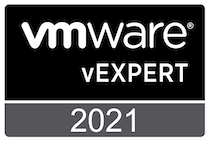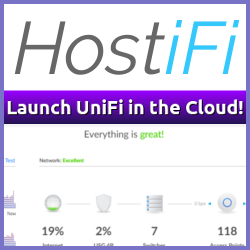On the 23rd of February 2021 VMware issued the VMSA-2021-0002 security advisory and one of the issues it addresses is VMware vCenter Server updates address remote code execution vulnerability in the vSphere Client (CVE-2021-21972). This is a critical issue, and if left unpatched could land your vSphere estate in big trouble as there is already Proof-of-Concepts available for this vulnerability. So get patching as soon as possible! Of course, this can only be exploited if you have access to the VMware vCenter Client, so if the managment plane is isolated that helps mitigate the risk.
 VMware has just announced the list of vExperts for 2021 and true to tradition here is a list of the Norwegian vExperts for 2021. This year there is a total of 13 Norwegian vExperts, one more than in 2020.
VMware has just announced the list of vExperts for 2021 and true to tradition here is a list of the Norwegian vExperts for 2021. This year there is a total of 13 Norwegian vExperts, one more than in 2020.
If you want to be included in this list when it opens up again in June 2021, it’s time to start plannning. As a vExpert Pro I’m happy to assist anyone who wants help applying!
I use Node-RED extensively for home automation purposes, in conjunction with Home Assistant. See the Home Automation tag for posts in that series. This post, however, is for a different use case and not home automation. For years I’ve been using Zapier to automatically tweet new posts for this site via the @vninjanet account, but that has proven rather inflexible and I wanted a better way to automate this, while adding features that Zapier currently does not support like adding specific hashtags automatically. I have been using the sites RSS feed as the trigger in Zapier, and wanted to continue doing that, even if moving it to Node-RED.
Sonos Beam is my main driver for television audio, which is great, but the sound travels between the floors in my house so I want Night Mode to be enabled late at night. I also do not want to manually have to tweak the night mode settings, and figured that doing it on a schedule, from within Home Assistant was the way to go.
I need my caffeine fix. It also needs to be very readily available when I wake up. Before home automation, I used to load my Moccamaster KBGT741 Thermal Coffee Maker with water and ground coffee before bedtime so all I had to do was to hit the power button to get caffeine flowing. But why not schedule it to before I get up so that there is always fresh coffee available the instant I get up in the morning? Add an IKEA Trådfri Smart Outlet, and I can schedule my fix! Since the coffee maker brews into a insulated carafe, it doesn’t get burned if, I sleep in, while at the same time keeping it hot. That’s a win-win! I know, this method doesn’t provide the absolute best coffee experience, but as far as I’m concerned availability beats quality in the wee hours of the morning.
In my hallway there are a few Phillips Hue White and Color Ambiance Bulbs that I’ve had some fun with the last couple of years. Originally automated through IFTTT, they change color if one of my favorite football teams play a match. This has been working well for quite some time, but with IFTTT recently starting to limit the amount of Applets you can create, and the fact that they only run every 15 minutes, I decided to try and emulate the functionality I used with Home Assistant and Node-RED instead.
I’ve been running Home Asssistant (HA) in my network for well over a year now, and it’s primary use case has been connecting devices from different ecosystems into one management interface. Lately I have been migrating a few automations from native HA to Node-RED, which has been a fun exercise, and I’m looking to expand the usage of automations in the time to come.
My mantra for this setup is that everything that can be automated, should be automated, while at the same time keeping it as simple and unobtrusive as possible for everyone in the household.
Misleading title, I know, especially considering most of this post is actually looking back at 2020. It’s been a few years since I did one of these posts, and with the havoc of 2020 close to be firmly in the rearview mirror, why not try to pick it up again?
Since I didn’t post a list of goals for 2020, it’s hard to review it item by item, but it’s safe to say that 2020 has been one hell of a year. A lot of people have been much more adversely affected by the whole COVID-19 pandemic than I have, but being confined to the Home Office of Isolation™ since March has taken it’s toll, at least mentally.
I’m lucky enough to have my own dedicated office, grown kids that doesn’t need home schooling and an employer who facilitates, and embraces, remote work. I know everyone else doesn’t have that luxury, given their role, but for those of us who has, it is a blessing.
2020 has also shown us who the real heroes are, the front line workers who can’t do their job from a comfortable and safe home office. Health care workers, teachers, public transport, shop workers and others who provide crucial services. On behalf of us lucky ones, thank you for beeing there. Thank you for caring, and thank you for making it possible for the rest of us to continue working. Hopefully 2021 will be better, at least eventually, as the vaccines become available, and we can start to slowly return to a new kind of normal.
Since I recently got an Elgato Key Light Air for the Home Office of Isolation™, I’ve been playing around with how to automate it. I’ve seen a lot of people using Elgato Stream Decks for automating these lights, but I don’t really have the need for a dedicated device for this. At least not yet.
As it turns out, it’s actually pretty easy to automate these lights via other means. The light itself runs a http server on port 9123, and via /elgato/lights it’s possible to connect to it’s internal API for remote control.
There is even a Postman Collection available, which makes it very easy to get started with connecting and changing settings around.
Ryan Johnson who works on VMware Validated Design, has created a GitHub repo for VMware stencils. The repository contains the stencils used for VMware Validated Designs in SVG, Visio and OmniGraffle formats, as well as a very nice Powerpoint presentation that shows how to use the stencils. Great work Ryan, and team!
About
vNinja.net is the online hub of Christian Mohn and Stine Elise Larsen.
The site primarily focuses on IT architecture and data center technologies, with a strong emphasis on virtualization and related topics.While the main content revolves around these areas, you'll also find a range of other subjects covered from time to time, reflecting the interests of authors.
